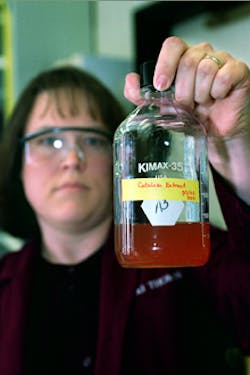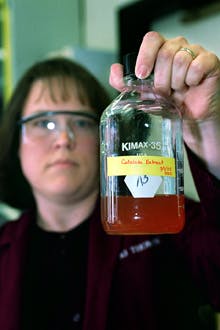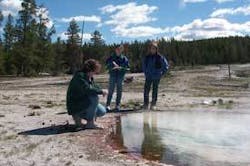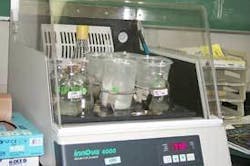‘Green’ Enzymes: Extremophiles Naturally Eliminate Hydrogen Peroxide from Industrial Wastewater
Hydrogen peroxide (H2O2) has become the “green solution” for bleaching, cleaning and disinfecting in a wide range of industries, including textile, pulp, paper, food preparation and food packaging. But it has one drawback - after its job is done, the H2O2 has to be eliminated from the industrial wastewater. That problem has been solved, however, by scientists at the Idaho National Laboratory (INL) in Idaho Falls. Using a unique enzyme found in the hot springs of Yellowstone National Park, the lab has developed a method of naturally removing the H2O2 from industrial-level wastewater, resulting in a significant savings of time, energy and money.
The use of special types of enzymes, catalases, is not new to chemists in the removal of H2O2 in environments with moderate temperatures. But with industrial processes which operate at extremely high temperatures and pH levels, the standard enzymes are quickly destroyed. Until now, scientists working with commercial catalases have had to make a choice: either spend time and money bringing wastewater temperatures and pH down to tolerable levels, or continually add more catalase to untreated wastewater to replenish the enzyme.
That was before INL scientists discovered the naturally occurring bacterium, Thermus brockianus, in the hot springs of Yellowstone Park. This bacterium produces an enzyme that can endure harsh industrial conditions like high temperatures and high pHs, and lasts thousands of times longer than alternative catalases. With the use of T. brockianus catalase, H2O2 decomposes safely, and wastewater needs no extra pretreatment. In addition, the enzyme lasts long enough to treat multiple batches of wastewater.
R&D Magazine named the isolation and production of this enzyme as one of the 100 most significant technological achievements of 2004. Known as the Ultrastable Catalase Enzyme, this catalase was discovered and developed by INL chemical engineer Vicki Thompson and biologists William Apel and Kastli Schaller. According to Thompson, large-scale production of the T. brockianus enzyme could end decades of environmental costs from a wide variety of industries.
In the food processing industry, H2O2 is used to eliminate Salmonella, E. coli and other toxic bacteria on fresh produce. Even fast food restaurants are using it to prevent the shriveling or discoloration on fruits and vegetables when exposed to air. Hydrogen peroxide is used to pasteurize dairy products and sterilize paper food packages such as juice boxes, eliminating the need for refrigeration.
Textile and paper manufacturers are switching from toxic chlorine bleach to the safer H2O2 to whiten and disinfect products. Chlorine, used for more than a century, forms toxic and carcinogenic chemicals as byproducts. Industries switching to greener H2O2 have developed wastewater treatment options - though all have come with extra cost or environmental problems.
With the T. brockianus catalase, H2O2 decomposes safely, and wastewater needs no extra pretreatment. In addition, the enzyme lasts long enough to treat multiple batches of wastewater. Unlike most commercial enzymes, it’s successful in industrial wastewater because it’s isolated from an extremophile - an organism that can live and thrive in environments that are extremely hot or cold, highly alkaline, acidic or salty, or that have above-normal radiation or extremely high pressures.
The INL team isolated the catalase enzyme from T. brockianus and found its industrial half-life to be 15 days instead of the 15 seconds of other catalase enzymes - an 86,000-fold improvement. Scientists use an enzyme’s half-life - the amount of time it takes to lose half its effectiveness - as a yardstick for comparing two enzymes.
The INL team is discussing collaborations for industrial development with major enzyme manufacturers. After isolating and producing large quantities of the enzyme in the lab, scientists can use existing technology to chemically bind them to tiny plastic beads the size of sand grains. Columns packed with the plastic-and-enzyme beads can filter wastewater and break down hydrogen peroxide. And since the enzyme retains its stability, the beads can be reused to treat additional batches of wastewater.
The Idaho National Laboratory advances U.S. Department of Energy strategic goals on environmental, energy, science and national security. It’s operated for the DOE by the Battelle Energy Alliance. Contact: Vicki Thompson, 208-526-8833, [email protected]



